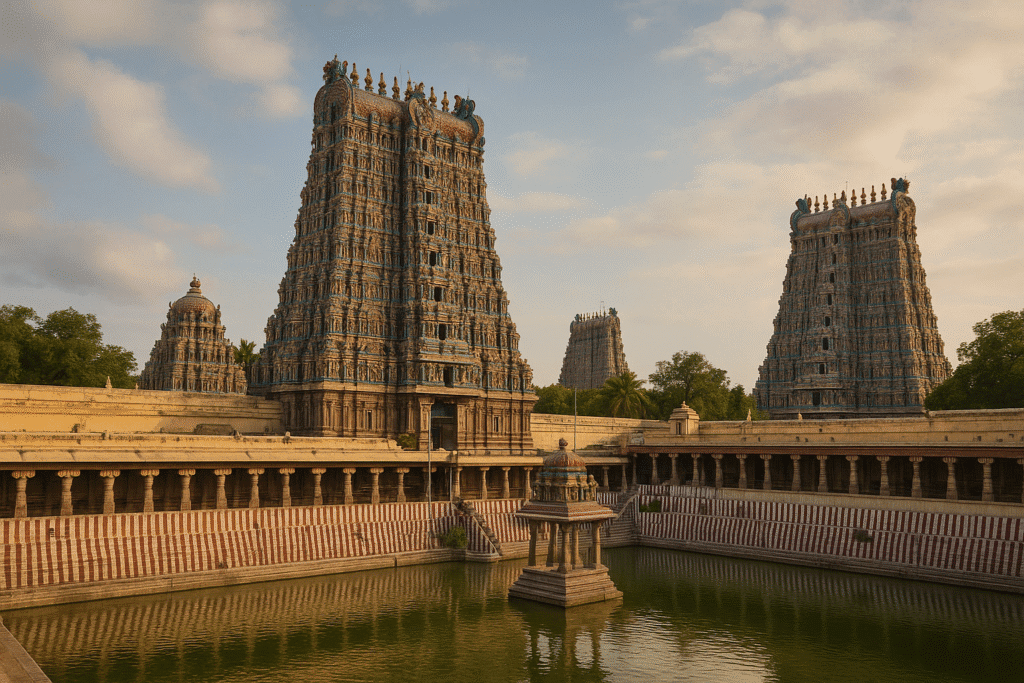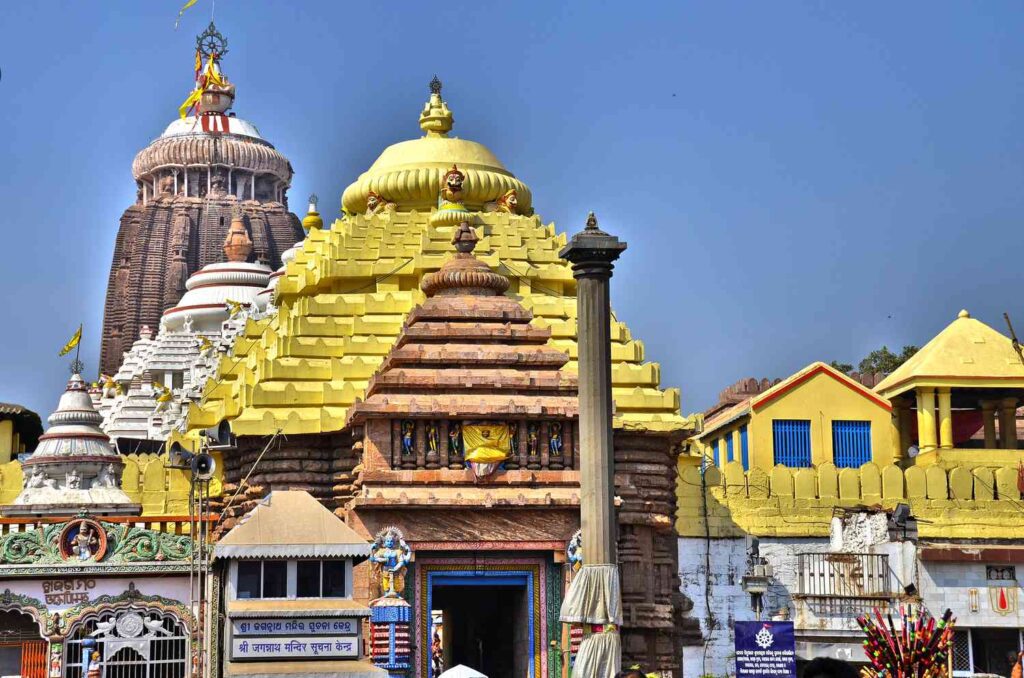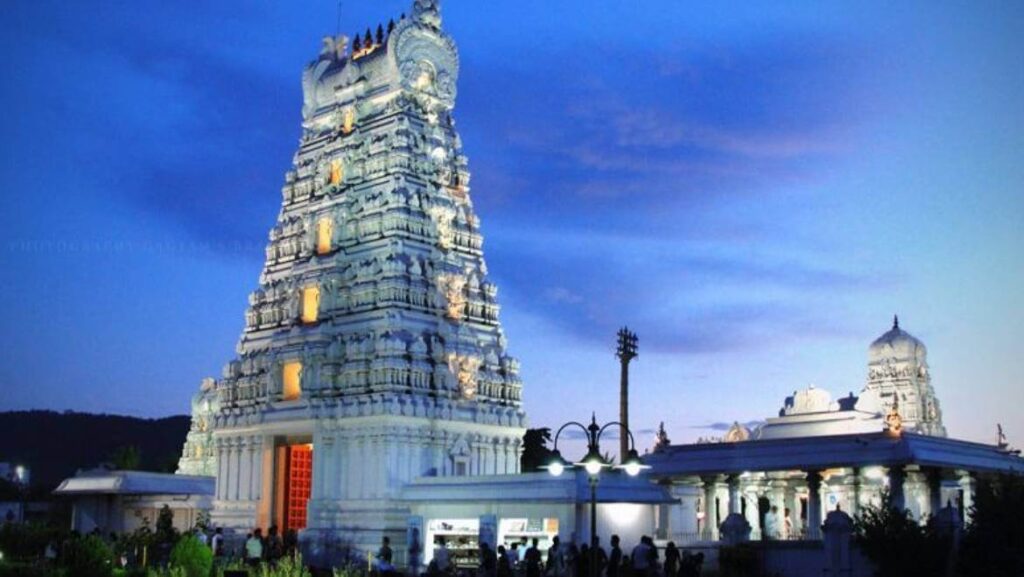Nestled in the heart of Madurai, Tamil Nadu, the Meenakshi Temple stands as a timeless testament to India’s rich cultural heritage, architectural brilliance, and spiritual depth. Dedicated to Goddess Meenakshi (an incarnation of Parvati) and her consort Lord Sundareswarar (Shiva), this ancient temple is not just a place of worship but a vibrant symbol of Dravidian artistry and devotion. Revered as one of the most significant temples in India, it attracts millions of devotees and tourists annually, offering a glimpse into the grandeur of South Indian temple architecture and traditions. This article delves into the temple’s history, architecture, cultural significance, festivals, and enduring legacy.
1. Historical Roots of the Meenakshi Temple
The Meenakshi Temple’s origins are steeped in legend and history, tracing back to the ancient Pandya dynasty:
- Mythological Beginnings: According to Hindu mythology, Goddess Meenakshi, born as Princess Tatatakasundari to the Pandya king Malayadwaja, was a divine incarnation of Parvati. She ruled Madurai and married Lord Shiva, who appeared as Sundareswarar. The temple commemorates their celestial union.
- Historical Evolution: While the temple’s origins are believed to date back to the 1st century CE, the current structure was largely built between the 12th and 18th centuries under the Pandya and Nayak rulers. The Nayaks, in particular, expanded the temple complex during the 16th–17th centuries, adding iconic gopurams (towering gateways).
- Archaeological Evidence: Inscriptions and texts, such as the Tiruvilaiyadal Puranam, document the temple’s prominence as a center of religion and culture in ancient Tamil Nadu.
- Restoration Efforts: Over the centuries, the temple has undergone renovations to preserve its grandeur, with contributions from various rulers, devotees, and modern conservation initiatives.
2. Architectural Splendor: A Dravidian Masterpiece
The Meenakshi Temple is renowned for its awe-inspiring Dravidian architecture, characterized by intricate carvings, towering structures, and vibrant colors:
- Gopurams: The temple boasts 14 gopurams, with the tallest marking the four main entrances. The southern gopuram, standing at 52 meters, is the tallest and features over 1,500 sculptures of gods, goddesses, mythical creatures, and celestial beings.
- Mandapams: The temple complex houses several pillared halls, including the iconic Thousand Pillar Hall (Ayiram Kaal Mandapam), which features 985 intricately carved pillars. This hall, a marvel of engineering, also serves as a museum showcasing sculptures and artifacts.
- Vimanas: The sanctum sanctorum of Goddess Meenakshi and Lord Sundareswarar is crowned with golden vimanas (towers), symbolizing divine radiance and spiritual ascendancy.
- Sacred Tank: The Porthamarai Kulam (Golden Lotus Tank) within the complex is a serene water body used for ritual baths, believed to have been created by Lord Indra.
- Sculptures and Paintings: Every inch of the temple is adorned with vibrant stucco images, frescoes, and stone carvings depicting scenes from Hindu mythology, showcasing unparalleled craftsmanship.
- Layout: Spanning 14 acres, the temple follows a concentric layout with multiple prakarams (corridors) leading to the inner sanctums, embodying cosmic symbolism and spiritual progression.
3. Spiritual Significance
The Meenakshi Temple is a living spiritual hub, drawing devotees seeking divine blessings and inner peace:
- Deities: The temple is primarily dedicated to Goddess Meenakshi, revered as the divine mother, and Lord Sundareswarar, symbolizing the eternal union of Shakti (divine feminine energy) and Shiva (divine masculine consciousness).
- Daily Rituals: The temple follows a rigorous schedule of six daily pujas, accompanied by Vedic chants, music, and offerings, creating an atmosphere of divine communion.
- Pilgrimage Importance: As one of the 64 Shakti Peethas (sacred abodes of the Goddess), the temple holds immense significance for devotees of Shaktism and Shaivism.
- Symbolism: The temple’s architecture and rituals reflect the philosophy of harmony between human life, nature, and the divine, emphasizing devotion, discipline, and spiritual awakening.
4. Festivals and Celebrations
The Meenakshi Temple comes alive during its vibrant festivals, which blend spirituality, tradition, and community participation:
- Meenakshi Thirukalyanam: Celebrated in April–May, this grand festival reenacts the divine wedding of Meenakshi and Sundareswarar. The celestial marriage, witnessed by thousands, is a highlight, with processions of deities in ornate chariots.
- Chithirai Festival: This 12-day event marks the Tamil New Year and includes the coronation of Meenakshi as Madurai’s queen, followed by processions and cultural performances.
- Navaratri: The nine-night festival honors the Goddess in her various forms, with the temple adorned in vibrant decorations and hosting classical music and dance performances.
- Theppotsavam: The float festival, held at the Mariamman Teppakulam tank, sees the deities taken on a decorated raft, symbolizing divine grace blessing the city.
- Cultural Extravaganza: These festivals showcase Tamil Nadu’s rich traditions through Bharatanatyam, Carnatic music, and folk arts, attracting artists and devotees from across India.
5. Cultural and Social Impact
Beyond its religious significance, the Meenakshi Temple has shaped Madurai’s identity as a cultural and social epicenter:
- Patronage of Arts: The temple has historically supported artists, musicians, and dancers, preserving classical art forms like Bharatanatyam and Carnatic music.
- Economic Hub: The temple sustains local economies by attracting tourists and pilgrims, supporting artisans, vendors, and hospitality businesses.
- Social Welfare: The temple administration runs charitable initiatives, including educational institutions, hospitals, and community kitchens, reflecting its commitment to societal upliftment.
- Global Recognition: Recognized as a UNESCO World Heritage tentative site, the temple is a global icon of India’s architectural and cultural legacy, inspiring awe among international visitors.
6. Modern-Day Relevance and Preservation
In the 21st century, the Meenakshi Temple remains a vibrant center of faith and heritage, adapting to modern needs while preserving its traditions:
- Tourism and Accessibility: The temple is a major tourist attraction, with guided tours, multilingual signage, and digital resources enhancing visitor experiences.
- Conservation Efforts: The Archaeological Survey of India (ASI) and temple authorities undertake regular restoration to protect the temple’s structures from environmental wear and urban pressures.
- Digital Presence: The temple’s festivals and rituals are live-streamed, allowing global devotees to participate virtually, bridging tradition with technology.
- Environmental Initiatives: Efforts like rainwater harvesting and eco-friendly practices during festivals reflect the temple’s commitment to sustainability.
7. Visiting the Meenakshi Temple: A Practical Guide
For those planning a visit, here are key tips to enhance the experience:
- Timings: The temple is open from 5:00 AM to 12:30 PM and 4:00 PM to 10:00 PM, with special darshan tickets available for quicker access.
- Dress Code: Modest attire covering shoulders and knees is mandatory, respecting the temple’s sanctity.
- Best Time to Visit: October to March offers pleasant weather, while festival seasons provide a vibrant experience.
- Etiquette: Photography is restricted in inner sanctums, and visitors are expected to maintain silence and reverence.
- Nearby Attractions: Explore Madurai’s other landmarks, like the Thirumalai Nayak Palace and Vandiyur Mariamman Teppakulam, for a holistic cultural journey.
Conclusion
The Meenakshi Temple is more than a architectural marvel; it is a living embodiment of India’s spiritual, cultural, and artistic heritage. Its towering gopurams, intricate carvings, and vibrant festivals narrate stories of devotion, creativity, and resilience. As a beacon of Dravidian grandeur, the temple continues to inspire awe and reverence, inviting visitors to immerse themselves in its divine aura. Whether you seek spiritual solace, architectural wonder, or cultural immersion, the Meenakshi Temple promises an unforgettable journey into the heart of Tamil Nadu’s timeless legacy.



